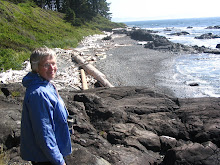 Image by (nz)dave via Flickr
Image by (nz)dave via Flickr
Who is involved in the sharing phase of inquiry learning?Both the student(s) sharing the learning and the audience (viewers, listeners) are part of the "who". Students may have worked alone on a project so that the sharing phase is a solitary venture. However, sometimes the individual inquiry projects may be brought together for the sharing phase so that students can begin to synthesize learning. (e.g. Students working on a biography project create a timeline of important events in a life. Teacher then brings small groups of students together to design a presentation which intermingles the people's lives. I did this project with Grade 5 students. The groups shared a movie and two skits which brought their individual biography subjects together.)
The project may have been collaborative from the start. Students may work in pairs or small groups. (One aspect which teachers of the inquiry process may need to spend more time on is building those social skills and collaborative skills if asking students to work together. In the biography project above, some students almost came to blows because they clung to their own ideas and refused to listen to the rest of the group. I had to spend more time on group skills to support their inquiry learning work.)
Recently there has been a push to do inquiry learning within e-collaborations. Kim Cofino of the International School in Bangkok, Thailand has written this blog post (
http://mscofino.edublogs.org/2009/10/04/how-to-connect-your-students-globally/) to give teachers support with setting up groups which will collaborate digitally.
The other "who" of sharing is the audience. In the past, students shared the product of their research (generally a research essay) with only the teacher. (Kuhlthau, 2007) With inquiry learning, the goal is to create a community of learners who engage with the learning products together. Students may share their learning with one other student, in a small group of students, to the whole class, or to the whole school. Students may even be invited to go outside of their school to share in a different venue. With online communities, students may be sharing their learning (especially in the form of a blog post, VoiceThread, or video) with a group of strangers that they never meet. Recently, Kim Cofino (teacher mentioned above) had a parents' morning. Parents brought their laptops and Kim taught them how to use an
RSS feed (
Google Reader) to aggregate all the class and school blogs. Suddenly those blog posts have a wider audience and students will be encouraged to do a better job on them. (Check out Kathy Cassidy's Grade 1 blog site.
http://classblogmeister.com/blog.php?blogger_id=1337,%20http://primarypreoccupation.wordpress.com/ She is a teacher in
Moose Jaw, Saskatchewan. People stop by from all around the world to read her students' blog posts. She recently used Skype to do Readers' Theatre with a class from the United States.)
The most common audience for student sharing is a group of people in the same room with the speaker. The student needs to be aware of background knowledge that the audience may possess. I recently attended a Web 2.0 workshop in which the presenter repeatedly checked in with the audience (who were strangers to her) to ask about basic concepts. Then if we already knew about the concept, she moved past it. In my Twitter workshop, I first thought that my audience would be pre-service education students. I thought about what their motivations may be for learning about Twitter. I planned a short get-acquainted activity before the workshop began. However, when no education students signed up, I was not sure who my audience would be. I had four people attend (three were teachers and one an ESL student). I had to revise the focus of my presentation because of my audience. I wasn't well prepared for the ESL student who at one point tweeted: I'm lost. Know your audience! (For some questions to ask to prepare for the audience go to
http://virtualinquiry.com/scientist/scientist3audience.htm)
What is involved in the sharing phase of inquiry learning?According to the book Guided Inquiry (Kuhlthau, 2007), the sharing phase of inquiry learning includes both a product of learning and the action of sharing that learning. The product may have been created in its final form during the creation phase. However, many projects involve the creation of a research essay which can not easily be shared with an audience. Therefore students will need to create something which can be shared with an audience. (e.g. Grade 6 students did research essays on the birds and animals we might see at camp. Then they created posters for the bird or animal they researched. At camp, these posters were on display. Throughout camp, each student gave a short speech about their bird or animal.)
The product may be decided at the beginning of the inquiry process (e.g. Grade 4 Science - amusement park rides) or may arise more naturally throughout the inquiry process. With students who are new to inquiry learning, teachers may tell them what they will share ("we are making powerpoints or posters to share our learning") while with students more experienced in inquiry learning, they may choose their own unique final product.
When students are choosing how to share,
Multiple Intelligences thinking could be part of the process. Teachers who are suggesting various products could think of the various Multiple Intelligences when designing the projects. There are some helpful worksheets within the Appendices of
Focus on Inquiry (See A, B, D, & E) which could help students understand their preferences in selecting products of learning. Here is a list of possible products of research (not all will be appropriate for sharing with an audience).
http://www.sdst.org/shs/library/fiftyways.html Here is a list of digital tools for creating projects
http://www.enquiringminds.org.uk/try_it/digital_tools/?cost=0&stage=4&tag_id=0&orderby=ASC&ajax=false&x=37&y=13Speeches: One of the most common ways of sharing learning is through a speech. The speech may stand-alone or may include visuals, a poster, or a powerpoint slide show. Students who have never given a speech may be very nervous. In my classrooms, I have always had students take turns leading opening exercises. This seems to help them in developing those skills in public speaking. Students should practice making eye contact, speaking clearly, using gestures, and organizing content well.
List of public speaking resources:
5th Grader speech (Excellent--eye contact, enthusiasm, humour, 3 points, gestures)
http://www.youtube.com/watch?v=G-eStp4NqBUMany resources for public speaking
http://www.cybraryman.com/publicspeaking.htmlTips from Craig Kielburger (video)
http://www.youtube.com/watch?v=GV-PzZwEd7sAdorable video of 3 year old Chinese boy public speaking (watch for what he does right: gestures, eye contact, enthusiasm, brevity. Wrong- too dependant on notes. But what can I say, reading and speaking at three.)
http://www.youtube.com/watch?v=oBd1xIt32kUAnimated training for giving a speech
http://www.curriculumbits.com/prodimages/details/english/eng0006.htmlPowerpoint: If students choose to use a powerpoint as their means of sharing their learning, there are various considerations. If the powerpoint will be presented along with a speech, the latest guidelines for powerpoints are that they should contain little text and more pictures. (See Joyce Valenza's blog post
http://www.schoollibraryjournal.com/blog/1340000334/post/130020413.html) Powerpoints can be uploaded to Slideshare for other people to view. I think that if the powerpoint is a stand-alone vehicle for sharing, it does need more text on each page. Most students will use it in combination with a speech and then less text will be best.
Videos: Resources for those making videos
http://www.thedirectorintheclassroom.com/resources.phpPosters: Ideas for creating poster displays (intended for older students)
http://www.ce.umn.edu/~smith/supplements/poster/guide.htmMaking a display board for science fair
http://www.super-science-fair-projects.com/elementary-science-fair-projects.htmlDebates: Students may use a debate as a way of sharing their learning. (After my grade 6 students had researched and presented on alternative forms of energy, I had them face-off and debate on why their form was better than the other person's form. This type of debate can lead to higher levels of thinking.) Resources for debate:
http://www.cybraryman.com/debate.htmlI know this section has been long. My goal has been to include some of the resources I have discovered that can be used by teachers and students in creating some of the products that they will share.
For my Twitter workshop, I used a data projector and a handout for each student. I actually had one of my students who was new to Twitter demonstrate step-by-step how to open and use a Twitter account. Her actions were displayed on the screen and I talked about the process as we went along. My presentation was very hands-on and interactive since every student sent two tweets and followed other people and replied to a message. At the end, I talked about the value of Twitter.
The next section is about the When and Where of the sharing phase of inquiry learning. (
Click here.)
 Image via Wikipedia
Image via Wikipedia![Reblog this post [with Zemanta]](http://img.zemanta.com/reblog_e.png?x-id=6a5fa27c-e846-4852-8965-51af87590163)

![Reblog this post [with Zemanta]](http://img.zemanta.com/reblog_e.png?x-id=0ee76576-2afb-40a5-a16a-4e3577a33dae)

![Reblog this post [with Zemanta]](http://img.zemanta.com/reblog_e.png?x-id=37cf193c-7ce2-4f7a-8551-bba54422a005)




